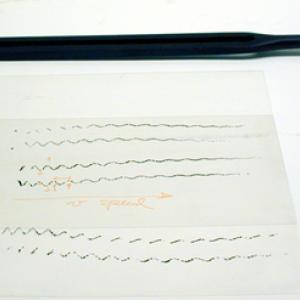College of Liberal Arts & Sciences
3D46.30 - Tuning Fork Motion
Attach a couple of pen tips to the holes at the end of the low frequency tuning fork. Start the fork vibrating and draw across the top of the transparency. Practice will be required to get a good trace. The trace should show that the two tines of the fork are always in opposition when vibrating. For instance they are always moving towards or away from each other.
You can also observe tuning fork motion by holding a vibrating fork in front of a television screen or computer monitor. The television or monitor will act like a slow cycling strobe light and the forks will look like they are bending.
- Lior M. Burko, "Erratum: Gravitational Wave Detection in the Introductory Lab, Phys. Teach. 55, 288 (2017)", TPT, Vol. 57, #4, Apr. 2019, p. 211.
- Nicolas Gonzalez and Eric Muller, "More Rolling Shutter Effects", TPT, Vol. 57, #1, Jan. 2019, p. 64.
- Eric Muller, "Scanning for Time: Science and Art on a Photocopier", TPT, Vol. 57, #1, Jan. 2019, p. 9.
- Bogdan F. Bogacz, Antoni T. Pedziwiatr, "The Sound Field Around a Tuning Fork and the Role of a Resonance Box", TPT, Vol. 53, #2, Feb. 2015, p. 97.
- Henry W. Leap, "The Rotating Tuning Fork", TPT, Vol. 22, #4, Apr. 1984, p. 208.
- Mario Iona, "Sound Around A Tuning Fork", TPT, Vol. 13, #6, Sept. 1975, p. 324.
- Robert F. Neff, "A Quick Wave Phenomenon Quiz", TPT, Vol. 13, #3, Mar. 1975, p. 166.
- Daniel A. Russell, Justin Junell, and Daniel O. Ludwigsen, "Vector Acoustic Intensity Around a Tuning Fork", AJP, Vol. 81, #2, Feb. 2013, p. 99.
- Daniel A. Russell, "On the Sound Field Radiated by a Tuning Fork", AJP, Vol. 68, #12, Dec. 2000, p. 1139.
- Thomas D. Rossing, Daniel A. Russell, and David E. Brown, "On the Acoustics of Tuning Forks", AJP, Vol. 60, #7, July 1992, p. 620.
- M-880: "Tractor and Pendulum", DICK and RAE Physics Demo Notebook.
- W-265: "Tuning Fork and Tuned Cavity", DICK and RAE Physics Demo Notebook.
- A. D. Bulman, "Simple Harmonic Motion", Model-Making for Physics, p. 80.
- R. W. Pohl, "(3)", Physical Principles of Mechanics and Acoustics, p. 301.
- Pat Murphy, Ellen Macaulay, and the staff of the Exploratorium, "Vibrations", Exploratopia, p. 343.
- Borislaw Bilash II, David Maiullo, "Good Vibrations", A Demo a Day: A Year of Physics Demonstrations, p. 216.
- 148, "Tuning Fork Crescendo", Christopher P. Jargodzki and Franklin Potter, Mad About Physics, p. 56, 199.
Disclaimer: These demonstrations are provided only for illustrative use by persons affiliated with The University of Iowa and only under the direction of a trained instructor or physicist. The University of Iowa is not responsible for demonstrations performed by those using their own equipment or who choose to use this reference material for their own purpose. The demonstrations included here are within the public domain and can be found in materials contained in libraries, bookstores, and through electronic sources. Performing all or any portion of any of these demonstrations, with or without revisions not depicted here entails inherent risks. These risks include, without limitation, bodily injury (and possibly death), including risks to health that may be temporary or permanent and that may exacerbate a pre-existing medical condition; and property loss or damage. Anyone performing any part of these demonstrations, even with revisions, knowingly and voluntarily assumes all risks associated with them.

